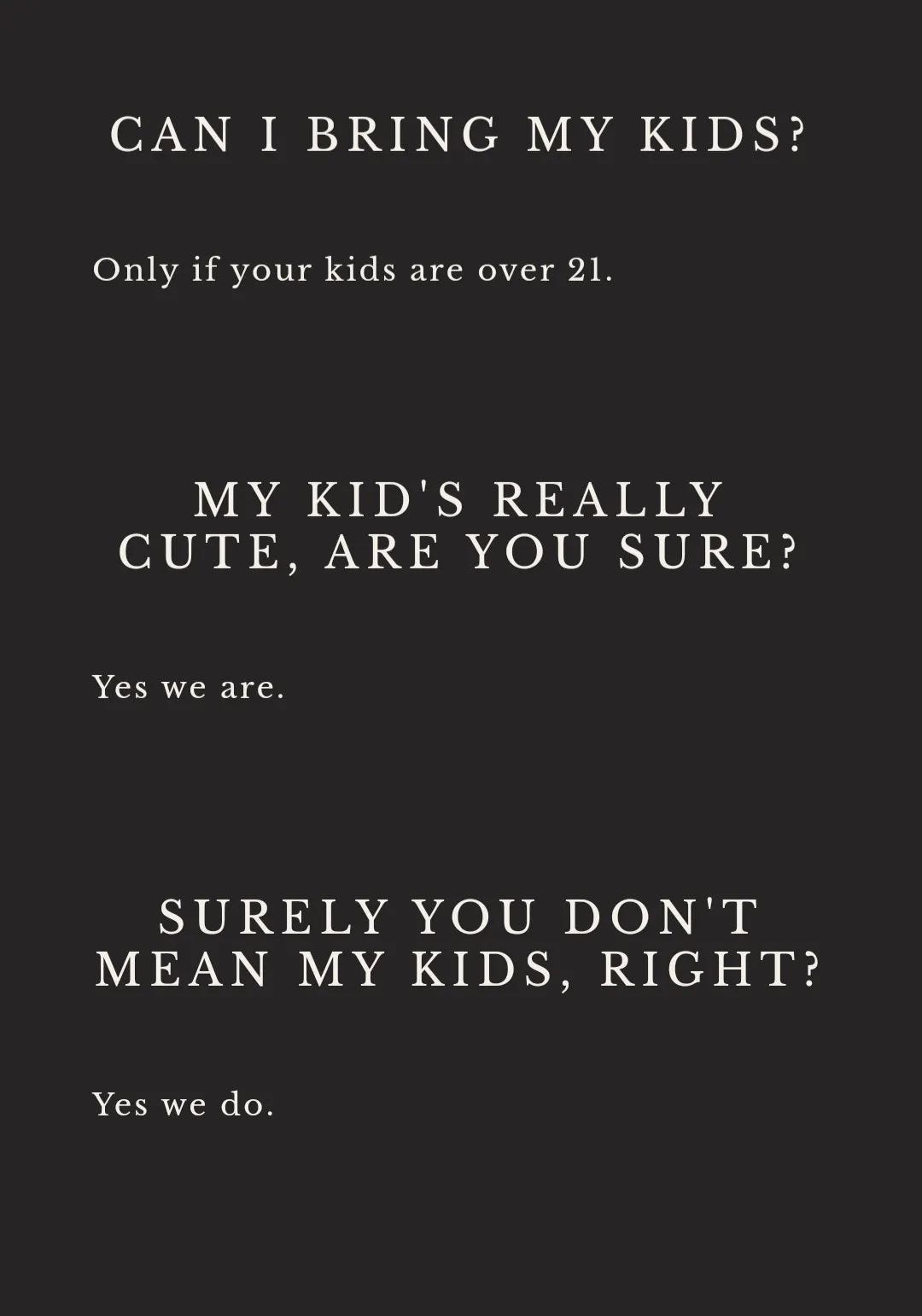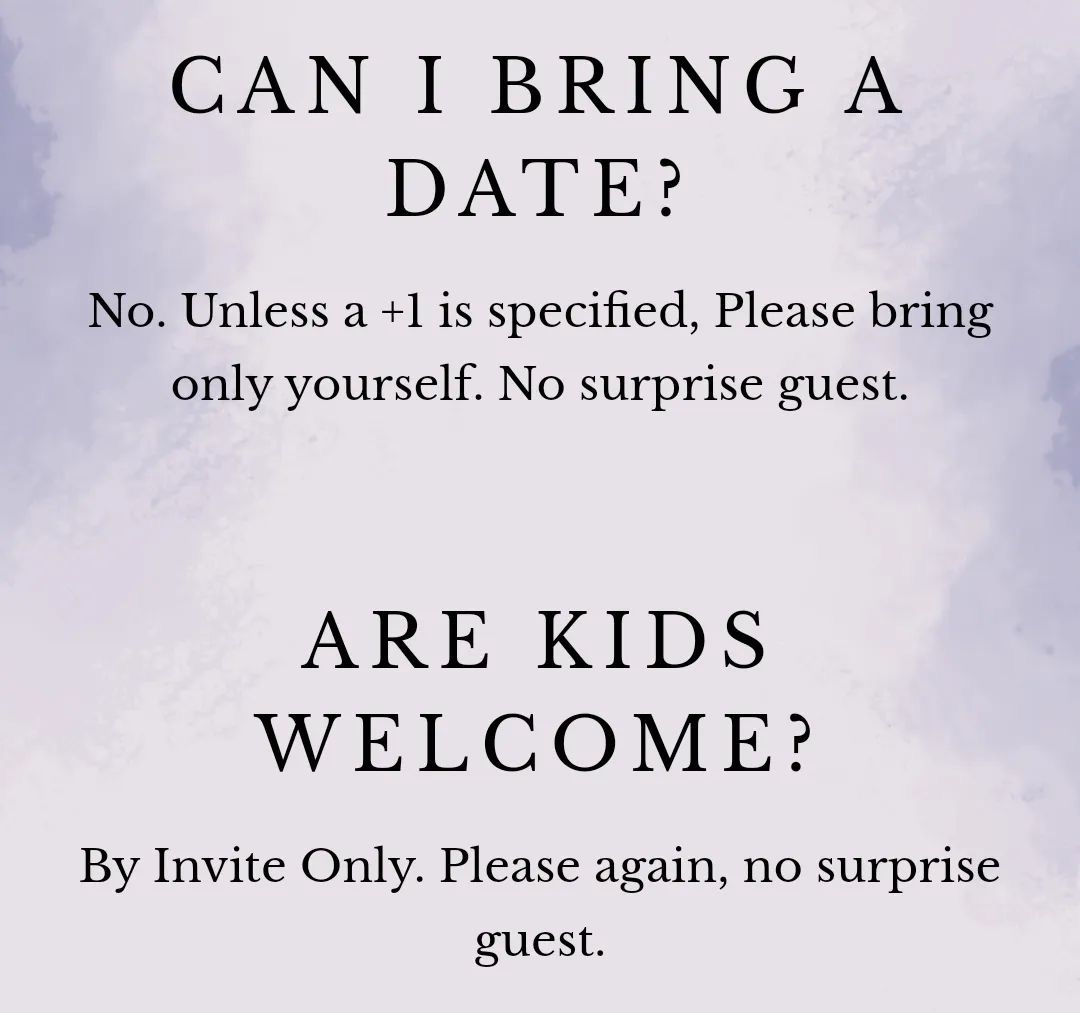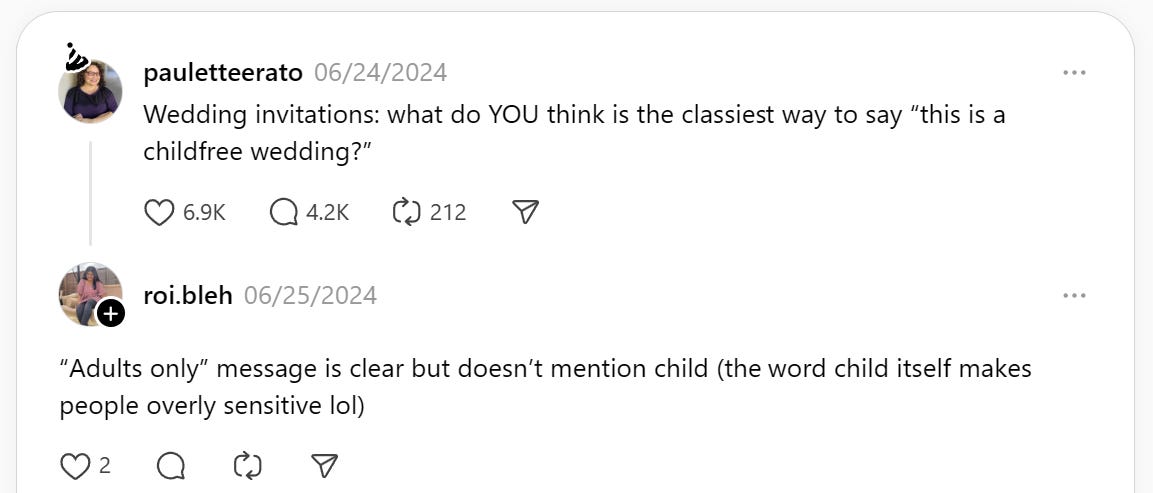There’s a certain art to hosting a wedding. It’s an expensive undertaking, especially if you fall into any of the many traps set by wedding industrial complex.
Like the idea one should spend 3 month’s salary on the engagement ring. That’s a quarter of your annual take-home pay!
Don’t fall for it. And don’t fall for another trap: that you have to invite EVERYONE to this event. You don’t. You can have age restrictions. Like no babies, or kids under 16.
In the latest episode of La Vida Más Chévere we discussed the nitty gritty of having a childfree wedding er, adult-only wedding, from our own experience.
There’s a right and wrong way to do it. And even some secret codes you can learn, like staying away from the phrase “childfree wedding.”
As someone pointed out in this thread:
“Adults only” message is clear but doesn’t mention child (the word child itself makes people overly sensitive lol).
5 Steps for an Adults-Only Wedding
In planning our own wedding(s), we learned a lot along the way:
Step 1 - Addressing the Invitation
Here’s another secret code: the way an invitation is addressed—specifically who it addressed to—is very important.
Inviting Mr. and Mrs. Smith is completely different than inviting The Smith Family, or Mr. and Mrs. Smith and Family.
So address the invitation appropriately.
But what about unmarried partners, people that are in long-term relationships but don’t live together, or new couples?
Etiquette indicates that if people live together, the partner is invited. If they don’t live together but have been in a relationship for a while, the addressed party receives a +1 in the form of the words “and guest.” Alternatively each side of the couple receives their own invitation.
But for new couples, this is a grey area. While we were able to extend a +1 to all our single friends because sometimes you need an emotional support human at these things, not everyone host has this ability. So this is up to the discretion of the hosts and their budget.
Step 2 - The RSVP Card
I learned this neat trick when my mom was planning my quinceñera: you get to tell people how many guests they’re allowed to bring!
RSVPs are crucial to any large party, especially when the host is paying a fee per each guest. So on the RSVP card that will be mailed back to the hosts, you can write in the max number of people your invitees can bring.
If you’re only inviting 1 person, write a 1. If a couple is invited, write 2. If you leave it blank, you’re asking for trouble.
With traditional wedding catering, the food is usually priced at base cost + tax + service charge (which hovers around 18-22%). As an example, some simple math:
Dinner = $50/person
Tax = 10% ($5)
Service charge = 20% ($10)
Suddenly that drives your per person costs to $65 each.
(Event planner secret: buffets, while less formal, are usually more expensive than plated dinners. But your caterer should always have at least 3% extra plates in case anyone is rude enough to show up without RSVPing, or worse, with an unexpected guest. Confirm this with catering, and make sure it’s in your contract!)
Obviously this is different if you’re hosting a more casual affair, like a backyard BBQ or potluck reception. Those are great cost-saving tactics. But if you are doing the whole lunch or dinner shebang, make sure your RSVPs are on point.
Step 3 - Wording the Invitation
The magic words “adults only” have to appear somewhere on both your save the dates AND your invitations. This isn’t something you want to hide from guests.
To ensure everyone is aware of any age restrictions from the very beginning, circulate the info early.
Because we had kids at our ceremony, we used the phrase “adults only reception to follow” on our invitations.
This is especially critical if your chosen venue isn’t particularly child-friendly. Like a spot in the Tenderloin district next to a strip club.
Or on a rooftop deck.
Make sure those magic words are on your invitations.
Step 4 - The Wedding Website
As wedding websites become more common for keeping your guests updated, also make sure the magic words are on your site. Use FAQs to answer the questions you know people will ask.
Even post it a couple of different ways. Here are some examples from Threads commenters.
Example 1

“Q: Can I bring my kids?
A: Only if your kids are over 21.
Q: My kid’s really cute, are you sure?
A: Yes, we are.
Q: Surely you don’t mean my kids, right?
A: Yes we do.”
Example 2

“Q: Can I bring a date?
A: No. Unless a +1 is specified, please bring only yourself. No surprise guest.
Q: Are kids welcome?
A: By invite only. Please again, no surprise guest.”
Example 3

“Please use our wedding website to RSVP. Although we love your little ones, this is an adult only affair.”
Of course, a Google search will lead you to many more examples of the “correct” wording, but at least these are real life practical ones to get you started.
Step 5 - Tell Everyone
When you draw your boundaries, you gotta enforce them. Which means using your words and telling people about them.
And make no mistake: deciding that you’re having a childfree wedding is a boundary. You might get some resistance. Hold firm anyway.
Make your intentions known. As mentioned above, you should put it on save-the-dates and invitations, but also give people the courtesy of a head’s up. A mass text or email, or even just a call to your most gossipy relative will do the trick.
Be prepared for the worst responses, especially if the kids in your circle or family are only 1-2 degrees away (like cousins or niblings). If friends and family are offended by this, you might have to make some hard decisions. Decide what you can live with because, as Ryan mentioned in the episode:
It's all about at the end of the day, at the end of the wedding, that you're now with this person for the rest of your life. No matter what happened on that wedding day.
Childcare: Yay or Nay?
One issue that many Threads commenters brought up was offering childcare. This is an excellent idea in theory. Here are some issues to consider:
Is there space at the venue for babysitting or will it have to be offsite?
Will there be a formally contracted service or will this fall on younger family members (who might be outnumbered by the little ones)?
Can you afford it?
Once you have all this squared away, you might still receive pushback. Some people are very wary of leaving their children with potential strangers, even if said strangers are from a professional bonded and vetted service. That’s their prerogative.
Should you offer it anyway? I think so, especially if you’re asking guests to travel long distances to your wedding. Finding local childcare can be really difficult, and you should extend help to your guests on this end if needed. Local hotels usually can assist, especially if you have a room block for all your guests to stay in.
Do you have to? Technically, no. But it’s a very nice thing to do for people spending their time and money to come to your nuptials.
The reality of having a childfree/adults-only wedding is that some people will not be able to make it due to having kids. You decide if you’re okay with that. Unfortunately you can’t have it both ways most of the time.
At the end of the day, think about what you want to remember (it’s going to be a big blur probably anyway). Do you want to be surrounded by only the adults that you love, or are a few kids worth it?
Another quote from my sidekick:
It's all about at the end of the day, at the end of the wedding, that you're now with this person for the rest of your life. No matter what happened on that wedding day.
Adults Only Wedding Bonus Tip #1
Want a near foolproof guarantee of a childfree wedding? Have a destination wedding!
Like bride Andrea explained on this episode, her wedding at a childfree resort in Mexico had all of 8 people in attendance but no babies among them!
That one’s on YouTube too:
Adults Only Wedding Bonus Tip #2
Another way to ensure a limit on having kids present: court house weddings.
Midweek, early morning when most kids are in school is an excellent time to say “I do.” This is how Ryan and I ended up having two weddings: we eloped at the county seat 4 months before “the big day.”
I even had my parents (I couldn’t go through with it without them) and our photographer in attendance. You need witnesses after all.
The judge who married us cracked funny wedding jokes, there was a gaudy canopy to say our vows under, and it took all of 10 minutes. Then we went out for bagels.
The midweek wedding is an excellent way to get the paperwork filed quickly, too. This is key if you’re expecting a name change. That marriage paperwork is required by everyone under the sun to make it happen. Even Marriott needed a copy in order to change my name in their customer loyalty account.
Which is as stupid as it sounds, yes.
How to Listen to Episode 67 - Saying "I Do" Without the Diapers: 5 Rules for a Childfree Wedding
Listen to Saying "I Do" Without the Diapers: 5 Rules for a Childfree Wedding on your favorite podcasting app or on Apple:
🎧Listen on Spotify:
💻“Watch” on YouTube:







